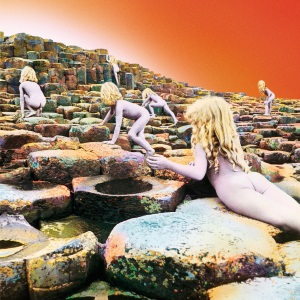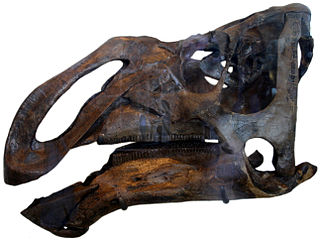
Houses of the Holy is the fifth studio album by the English rock band Led Zeppelin, released on 28 March 1973 in the United States and on 30 March 1973 in the United Kingdom by Atlantic Records. The album benefited from two band members installing studios at home, which allowed them to develop more sophisticated songs and arrangements and expand their musical style. Several songs subsequently became fixtures in the group's live set, including "The Song Remains the Same", "The Rain Song" and "No Quarter". Other material recorded at the sessions, including the title track, was shelved and released on the later albums Physical Graffiti (1975) and Coda (1982). All instruments and vocals were provided by the band members Robert Plant (vocals), Jimmy Page (guitar), John Paul Jones, and John Bonham (drums). The album was produced by Page and mixed by Eddie Kramer. The cover was the first for the band to be designed by Hipgnosis and was based on a photograph taken at Giant's Causeway in Northern Ireland.

John Harold Ostrom was an American paleontologist who revolutionized the modern understanding of dinosaurs. Ostrom's work inspired what his pupil Robert T. Bakker has termed a "dinosaur renaissance".

Kritosaurus is an incompletely known genus of hadrosaurid (duck-billed) dinosaur. It lived about 74.5-66 million years ago, in the Late Cretaceous of North America. The name means "separated lizard", but is often mistranslated as "noble lizard" in reference to the presumed "Roman nose".

Alamosaurus is a genus of titanosaurian sauropod dinosaurs containing a single known species, Alamosaurus sanjuanensis, from the Maastrichtian age of the Late Cretaceous period in what is now southwestern North America. It is the only known titanosaur to have inhabited North America after the nearly 30-million year absence of sauropods from the North American fossil record and probably represents an immigrant from South America.

Michael James Benton is a British palaeontologist, and professor of vertebrate palaeontology in the School of Earth Sciences at the University of Bristol. His published work has mostly concentrated on the evolution of Triassic reptiles but he has also worked on extinction events and faunal changes in the fossil record.
Shixinggia is a genus of oviraptorosaurian dinosaur from the Late Cretaceous period of Shixing County, Guangdong, China, for which it was named. While no skull was recovered, the specimen (BVP-112) is known from a fair amount of post-cranial material that shows it was a fairly derived oviraptorosaur, of superfamily Caenagnathoidea. Lü et al. describe it as an oviraptorid, but it could be a caenagnathid.
Thomas Richard Holtz Jr. is an American vertebrate palaeontologist, author, and principal lecturer at the University of Maryland's Department of Geology. He has published extensively on the phylogeny, morphology, ecomorphology, and locomotion of terrestrial predators, especially on tyrannosaurids and other theropod dinosaurs. He wrote the book Dinosaurs and is the author or co-author of the chapters "Saurischia", "Basal Tetanurae", and "Tyrannosauroidea" in the second edition of The Dinosauria. He has also been consulted as a scientific advisor for the Walking with Dinosaurs BBC series as well as the Discovery special When Dinosaurs Roamed America, and has appeared in numerous documentaries focused on prehistoric life, such as Jurassic Fight Club on History and Monsters Resurrected, Dinosaur Revolution and Clash of the Dinosaurs on Discovery.

Turiasaurus is a genus of sauropod dinosaurs. It is known from a single fossil specimen representing the species Turiasaurus riodevensis, found in the Kimmeridgian Villar del Arzobispo Formation of Teruel, Spain.

BBC Sessions is a compilation album featuring studio sessions and a live concert recorded by English rock group Led Zeppelin for the BBC. It was released on 17 November 1997, by Atlantic Records. Disc one consists of material from four different 1969 BBC sessions. Disc two contains most of the 1 April 1971 concert from the Paris Theatre in London. Disc three was only included in a limited run of album releases and features rare interviews from 1969, 1976/1977, and 1990.

Tastavinsaurus is a genus of sauropod dinosaur belonging to the Titanosauriformes. It is based on a partial skeleton from the Early Cretaceous Xert Formation of Spain. The type species is Tastavinsaurus sanzi, named in honor of the Rio Tastavins in Spain and Spanish paleontologist José Luis Sanz. Tastavinsaurus sanzi is known from two specimens, one from the Xert Formation and one from the Forcall Formation. Tastavinsaurus was originally described as a somphospondylan, but it may be a brachiosaurid. The clade Laurasiformes was coined for Tastavinsaurus and its close relatives, which may include Cedarosaurus, Soriatitan, and Venenosaurus.

Paleoart is any original artistic work that attempts to depict prehistoric life according to scientific evidence. Works of paleoart may be representations of fossil remains or imagined depictions of the living creatures and their ecosystems. While paleoart is typically defined as being scientifically informed, it is often the basis of depictions of prehistoric animals in popular culture, which in turn influences public perception of and fuels interest in these organisms. The word paleoart is also used in an informal sense as a name for prehistoric art, most often cave paintings.
Julius Thomas Csotonyi is a Hungarian-born Canadian paleoartist and natural history illustrator living in Winnipeg, Manitoba, Canada. He specialises in photo-realistic restorations of dinosaurs, paleo-environments and extinct animals. His techniques encompass both traditional and digital media. His art is included in museum displays in many countries. Csotonyi also created the design of the reverse side of the commemorative 25 dollar silver Royal Canadian Mint coin called 50th Anniversary of the Canadian Flag.

The fossil trade is the purchase and sale of fossils. This is at times done illegally with stolen fossils, and important scientific specimens are lost each year. The trade is lucrative, and many celebrities collect fossils.

Mauricio Antón Ortuzar is a paleoartist and illustrator specializing in the scientific reconstruction of extinct life, well known for his influential paintings of hominids, extinct carnivores and other vertebrate fossil groups. His works illustrate a great number of books, scientific papers, private collections and museums in many parts of the world. He currently works in association with the Natural Science Museum in Madrid.

Edwin Harris "Ned" Colbert was a distinguished American vertebrate paleontologist and prolific researcher and author.

Magnapaulia is a genus of herbivorous lambeosaurine hadrosaurid dinosaurs known from the Latest Cretaceous Baja California, of northwestern Mexico. It contains a single species, Magnapaulia laticaudus. Magnapaulia was first described in 1981 as a possible species of Lambeosaurus by William J. Morris, and was given its own genus in 2012 by Prieto-Márquez and colleagues.

Luis María Chiappe is an Argentine paleontologist born in Buenos Aires who is best known for his discovery of the first sauropod nesting sites in the badlands of Patagonia in 1997 and for his work on the origin and early evolution of Mesozoic birds. He is currently the Vice President of Research and Collections at the Natural History Museum of Los Angeles County and director of the museum's Dinosaur Institute. He was a postdoctoral researcher at the American Museum of Natural History, New York after immigrating from Argentina. Chiappe is currently the curator of the award winning Dinosaur Hall at the Natural History Museum of Los Angeles County, an adjunct professor at the University of Southern California, BBC advisor and author of scientific and popular books.
Davide Bonadonna is an Italian scientific and medical illustrator best known for his paleontological reconstructions of extinct animals. His work has been published in a number of books, museums, and magazines, including his murals in the National Geographic Museum's Spinosaurus exhibit and illustrations in books published by Simon and Schuster. He was awarded the Society of Vertebrate Paleontology's John J. Lanzendorf PaleoArt Prize in 2010 for his restoration of dinosaur Diplodocus carnegii.
El Papus was a weekly anarchist satirical magazine which existed between 1973 and 1987. Although it was subject to various negative events, it managed to continue and became one of the most popular publications in Spain.















